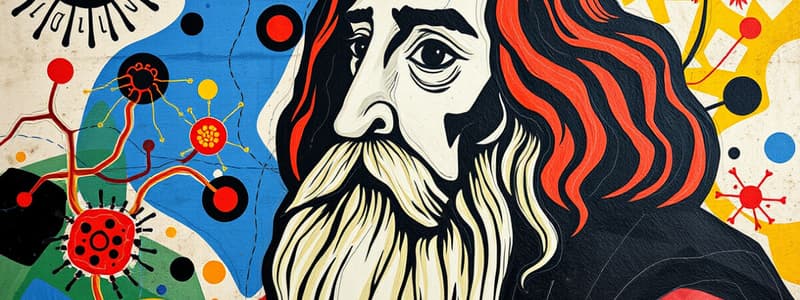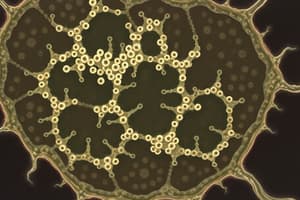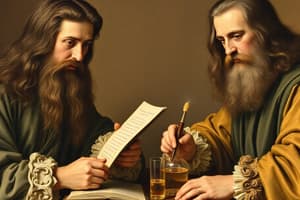Podcast
Questions and Answers
What was Anton van Leeuwenhoek's contribution to microbiological observation?
What was Anton van Leeuwenhoek's contribution to microbiological observation?
- He developed a theory linking microbes to disease.
- He discovered the process of pasteurization.
- He made observations using a primitive single-lens microscope. (correct)
- He conducted experiments disproving spontaneous generation.
What did Francisco Redi's experiment demonstrate about spontaneous generation?
What did Francisco Redi's experiment demonstrate about spontaneous generation?
- Maggots appeared only when meat was exposed to air.
- Heat could kill all sources of life, including microorganisms.
- Dead meat could produce maggots without the involvement of flies.
- Maggots were produced by flies, not spontaneous generation. (correct)
How did John Needham's approach differ from that of Francisco Redi's in their investigations of spontaneous generation?
How did John Needham's approach differ from that of Francisco Redi's in their investigations of spontaneous generation?
- Redi concluded in favor of spontaneous generation.
- Needham heated the meat in a closed flask. (correct)
- Needham included air exposure while Redi did not.
- Needham used open flasks while Redi used sealed ones.
What key revision did Lazarus Spallanzani make to John Needham's experiment?
What key revision did Lazarus Spallanzani make to John Needham's experiment?
What was the primary goal of Louis Pasteur's Swan Neck Flask Experiment?
What was the primary goal of Louis Pasteur's Swan Neck Flask Experiment?
What major theory did Louis Pasteur link microorganisms to?
What major theory did Louis Pasteur link microorganisms to?
What significant methodological contribution did Robert Koch make to microbiology?
What significant methodological contribution did Robert Koch make to microbiology?
Why did Louis Pasteur conclude that spontaneous generation did not occur?
Why did Louis Pasteur conclude that spontaneous generation did not occur?
What flaw did critics point out in Needham's experiment concerning the generation of life?
What flaw did critics point out in Needham's experiment concerning the generation of life?
What aspect did Spallanzani add to the scientific discussions surrounding spontaneous generation?
What aspect did Spallanzani add to the scientific discussions surrounding spontaneous generation?
What is one of the core requirements of Koch's Postulates?
What is one of the core requirements of Koch's Postulates?
Which limitation of Koch's Postulates is highlighted by the example of Helicobacter pylori?
Which limitation of Koch's Postulates is highlighted by the example of Helicobacter pylori?
What aspect of pathogenicity do Molecular Koch's Postulates emphasize?
What aspect of pathogenicity do Molecular Koch's Postulates emphasize?
Which experiment is famously used to disprove spontaneous generation?
Which experiment is famously used to disprove spontaneous generation?
What was a primary contribution of Pasteur to germ theory?
What was a primary contribution of Pasteur to germ theory?
Why did Needham's and Spallanzani's experiments yield differing results?
Why did Needham's and Spallanzani's experiments yield differing results?
What would have been the implication if Pasteur's experiment had supported spontaneous generation?
What would have been the implication if Pasteur's experiment had supported spontaneous generation?
Which of the following statements about the traditional Koch's Postulates is NOT true?
Which of the following statements about the traditional Koch's Postulates is NOT true?
What aspect of pathogenic organisms does Stanley Falkow’s Molecular Koch's Postulates account for?
What aspect of pathogenic organisms does Stanley Falkow’s Molecular Koch's Postulates account for?
Which of the following is NOT a requirement of Koch's Postulates?
Which of the following is NOT a requirement of Koch's Postulates?
What was a significant critique of Koch's Postulates regarding certain pathogens?
What was a significant critique of Koch's Postulates regarding certain pathogens?
How do Molecular Koch's Postulates differ from the traditional ones?
How do Molecular Koch's Postulates differ from the traditional ones?
What did Pasteur's Swan Neck Flask experiment aim to demonstrate?
What did Pasteur's Swan Neck Flask experiment aim to demonstrate?
Which of the following statements accurately reflects the contributions of Redi, Spallanzani, and Pasteur to spontaneous generation theory?
Which of the following statements accurately reflects the contributions of Redi, Spallanzani, and Pasteur to spontaneous generation theory?
What impact did Stanley Falkow's contribution have on understanding pathogenicity?
What impact did Stanley Falkow's contribution have on understanding pathogenicity?
In what way did Pasteur’s experiment design prevent contamination?
In what way did Pasteur’s experiment design prevent contamination?
What was a primary outcome observed in Pasteur's Swan Neck Flask experiment?
What was a primary outcome observed in Pasteur's Swan Neck Flask experiment?
What does the example of Helicobacter pylori illustrate about Koch's Postulates?
What does the example of Helicobacter pylori illustrate about Koch's Postulates?
Flashcards are hidden until you start studying
Study Notes
Early Observations and Theories
- Anton van Leeuwenhoek (1650) observed invertebrates using a single-lens microscope, wrongly attributing maggot production in rotting meat to "spontaneous degeneration."
- Francisco Redi (1668) conducted experiments demonstrating that maggots arose from flies, not spontaneously, using three flasks: one exposed to air, one with gauze, and one sealed.
- John Needham (1745) heated meat in a closed flask and observed maggots, suggesting spontaneous generation could occur without flies.
- Lazarus Spallanzani (1760) boiled meat broth, leading to no microbial growth, concluding that air or dust must have caused contamination in Needham’s experiments.
Louis Pasteur and the Refutation of Spontaneous Generation
- Louis Pasteur (1857) conducted the Swan Neck Flask Experiment, showing that air allowed gas exchange while trapping dust. No microbial growth for a year proved that contaminants, not air, led to spoilage.
- Pasteur introduced the Theory of Pasteurization, emphasizing that boiling and dust exclusion prevent spoilage.
- He also formulated the Germ Theory of Disease, linking microorganisms to disease causation.
Development of Koch’s Postulates
- Robert Koch (1880) established that specific microbes are responsible for specific diseases, identifying pathogens associated with cholera, anthrax, and rabies.
- Koch's Postulates outline criteria for proving a microbe causes a disease:
- Must be found in all disease cases,
- Must be isolated and grown in pure culture,
- Must reproduce disease when introduced to a susceptible host,
- Must be re-isolated from the experimental host.
- Limitations of Koch's Postulates include the assumption that pathogens are only found in disease and that not all can be cultured or tested on animals; for instance, Helicobacter pylori is part of healthy individuals' microbiota.
Molecular Koch’s Postulates
- Stanley Falkow (1988) revised Koch’s Postulates to emphasize identifying virulence genes, allowing for studying intracellular pathogens.
- Example: E. coli strains can become pathogenic when they acquire specific genes.
Summary and Reflections
- The theory of spontaneous generation claimed life arose from non-living matter; Redi, Spallanzani, and Pasteur’s work refuted this concept.
- Pasteur’s Swan Neck Flask experiment provided strong evidence against spontaneous generation, vital for advancements in microbiological theory.
Studying That Suits You
Use AI to generate personalized quizzes and flashcards to suit your learning preferences.




